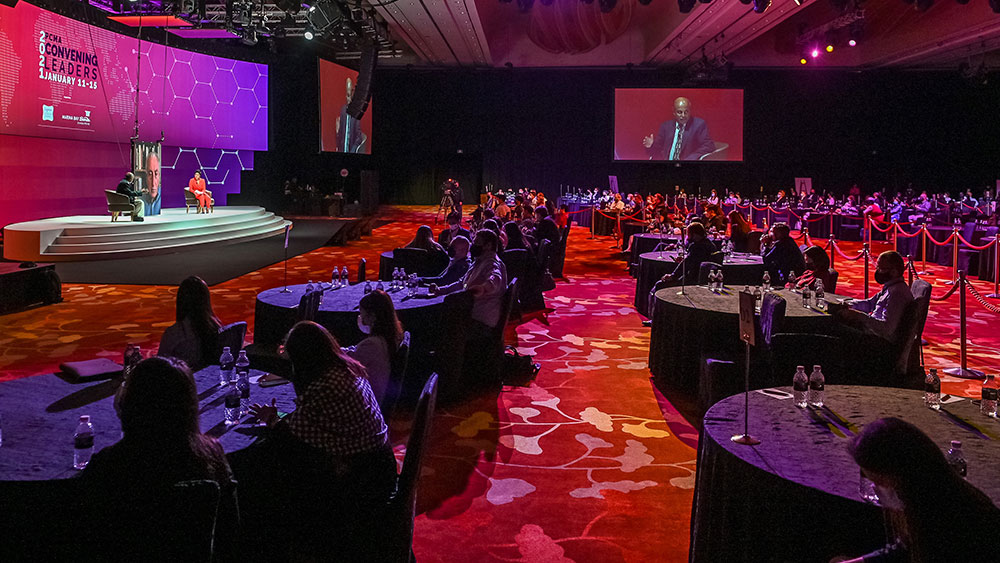
Respondents to the January Dashboard survey shared their thoughts on the cost of hybrid events like Convening Leaders 2021 (above). (Syafiq AB photo)
When we wrapped up the December Recovery Dashboard survey results, we noticed that both planners and suppliers reported feeling significantly more hopeful than in November. We attributed that to the timing of the survey, which went out the same week that the first wave of vaccines was being given to health-care workers.
Distribution of the vaccine in the weeks that followed that initial rollout was less promising and anything but smooth — vaccine shortages around the world, confusion around distribution plans that vary state by state in the U.S., and challenges with registration systems. Those frustrating realities dampened the hopes of participants — 491 planners and 219 suppliers — in our latest survey, conducted in late January. In December, 66 percent of planners said that news about vaccines had changed their thinking about what might be possible; January’s headlines caused it to drop to 60 percent. Supplier responses took more of a dip: 74 percent in December vs. 63 percent in January.
There were 6 percent fewer planners in January who described feeling hopeful — 48 percent vs. 54 percent in December. And slightly more planners — 35 percent vs. 31 percent in December — reported feeling anxious about the future.
Writing, “Frustrated by the slow recovery and rollout of the vaccine,” one supplier spoke for many. Yet, suppliers seemed to be faring better mentally in January than their planner colleagues — and feeling better than in December. Seven percent fewer suppliers this time around were feeling anxious (30 percent vs. 37 percent) and only 13 percent said they were exhausted and burned out, compared to 24 percent who said that in December. Additionally, 16 percent of suppliers vs. 10 percent in the previous survey said they were feeling inspired and creative; 27 percent vs. 20 percent in December described their frame of mind as “determined.”
That more resolute attitude could be interpreted as being behind how they were shifting their reskilling efforts: A slightly larger percentage of suppliers said they are working on new business models and scenario planning than in the previous month’s survey. And perhaps recognizing that we have a long road ahead of us before face-to-face events resume in full force, fewer are focused on designing live experiences — 35 percent in January vs. 44 percent in December.
Face to Face
At the same time, fewer suppliers envision hybrid events as the most likely recovery scenario — and 21 percent in January vs. 16 percent at the end of 2020 anticipate there will be a pent-up demand for groups to meet in person.
Suppliers are also more enthusiastic about their own recent experiences meeting face-to-face. Around one-third of participants said they had participated in a recent in-person event, but 77 percent in January said it was worth all of the precautions and safety measures, up from 65 percent in December. Only 21 percent (vs. 33 percent) rated their experience as only “okay” and didn’t see it appealing to groups. And yet, even with more than three quarters giving that face-to-face event a thumbs-up, that didn’t translate to a greater willingness to travel to an event — slightly more are unwilling to travel at all, and a lower percentage said they would go any distance if the program seemed worth it.
For their part, planners also are more unwilling to travel for an event than in December. And while a greater percentage attended an in-person event recently (23 percent vs. 18 percent in December), 63 percent (vs. 65 percent in December) said it was worth all the safety measures and more than one-third — a few percentage points more than the previous survey — don’t see it as an option for groups.
Fewer planners said they are launching an all-new digital event in 2021 than when we asked that question in December (45 percent vs. 51 percent), but more are seeking broadcast facilities for future hybrid events (39 percent vs. 34 percent).
Financial Realities
As the pandemic rages on, its economic impact on suppliers continues to grow — 22 percent of suppliers in January predicted revenue declines of greater than 75 percent in 2021 vs. 12 percent in December.
Planners who are budgeting for a hybrid event are finding the costs more difficult to justify: 44 percent said it was their top challenge in January vs. 37 percent in December. As one planner said, the issue is trying to design hybrid events “that are not double the expense and effort. Otherwise, live events won’t happen until the pandemic is over and digital will be a piece of the live event, but not the same production quality and effort of an all-digital event. Unless vendors can come up with a way to make that affordable, the large in-person meetings will continue to languish as it’s not commercially feasible to do both well right now.”
Another planner cited attrition penalties when face-to-face meetings resume — October 2021 at the earliest — as being problematic, “plus costs involved with stricter hygiene/safety protocols needed for in person meetings.” Concerns about similar “incremental COVID expenses” were shared by another planner — “in labor, exhibit space, meeting room, catering, GSC, sanitation, etc., to hold a safe, socially distanced meeting.”
One planner summed up the way forward succinctly: “Vaccines will dictate recovery. Until readily available universally, event business will be restricted. Even with facilities well-prepared on all aspects of safety, organizations will not be comfortable allowing members to travel until the vaccine process is complete.”
Michelle Russell is editor in chief of Convene.
Please download a PDF of the full January Recovery Dashboard results by clicking the link below.
Previous Recovery Dashboard Results
Find all the past results on our Recovery Dashboard archive page.
